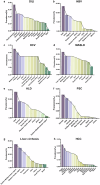Liver diseases: epidemiology, causes, trends and predictions
- PMID: 39904973
- PMCID: PMC11794951
- DOI: 10.1038/s41392-024-02072-z
Liver diseases: epidemiology, causes, trends and predictions
Abstract
As a highly complex organ with digestive, endocrine, and immune-regulatory functions, the liver is pivotal in maintaining physiological homeostasis through its roles in metabolism, detoxification, and immune response. Various factors including viruses, alcohol, metabolites, toxins, and other pathogenic agents can compromise liver function, leading to acute or chronic injury that may progress to end-stage liver diseases. While sharing common features, liver diseases exhibit distinct pathophysiological, clinical, and therapeutic profiles. Currently, liver diseases contribute to approximately 2 million deaths globally each year, imposing significant economic and social burdens worldwide. However, there is no cure for many kinds of liver diseases, partly due to a lack of thorough understanding of the development of these liver diseases. Therefore, this review provides a comprehensive examination of the epidemiology and characteristics of liver diseases, covering a spectrum from acute and chronic conditions to end-stage manifestations. We also highlight the multifaceted mechanisms underlying the initiation and progression of liver diseases, spanning molecular and cellular levels to organ networks. Additionally, this review offers updates on innovative diagnostic techniques, current treatments, and potential therapeutic targets presently under clinical evaluation. Recent advances in understanding the pathogenesis of liver diseases hold critical implications and translational value for the development of novel therapeutic strategies.
© 2025. The Author(s).
Conflict of interest statement
Competing interests: The authors declare no competing interests.
Figures








References
Publication types
MeSH terms
Grants and funding
- 82122009/National Natural Science Foundation of China (National Science Foundation of China)
- U23A20401/National Natural Science Foundation of China (National Science Foundation of China)
- 82322011/National Natural Science Foundation of China (National Science Foundation of China)
- 82225008/National Natural Science Foundation of China (National Science Foundation of China)
- 2021-I2M-5-003/Chinese Academy of Medical Sciences (CAMS)
LinkOut - more resources
Full Text Sources
Medical
Research Materials

